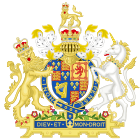The Oaths of Allegiance and Supremacy Act 1688 (1 Will. & Mar. c. 8) was an Act of the Parliament of England passed in the aftermath of the Glorious Revolution. The Act required all office-holders, Members of Parliament and clergy to take the oaths of allegiance and supremacy for the new monarchs, William III and Mary II. The Archbishop of Canterbury, William Sancroft, five bishops and approximately four hundred lower clergy refused to take the oaths because they believed their oaths to James II were still valid. The Act thus triggered the nonjuring schism in the Church of England. The non-jurors were deprived of their offices.[1]
| Act of Parliament | |
 | |
| Long title | An Act for the Abrogating of the Oathes of Supremacy and Allegiance and Appointing other Oathes. |
|---|---|
| Citation | 1 Will. & Mar. c. 8
|
| Dates | |
| Royal assent | 24 April 1689 |
| Repealed | 13 July 1871 |
| Other legislation | |
| Amended by | Statute Law Revision Act 1867 |
| Repealed by | Promissory Oaths Act 1871 |
| Relates to | Oaths Act 1688 |
Status: Repealed | |
| Text of statute as originally enacted | |
| Oaths Act 1688 | |
|---|---|
| Act of Parliament | |
 | |
| Long title | An Act to Regulate the Administracion of the Oathes required to be taken by Commission or Warrant Officers imployed in their Majestyes Service by Land by Vertue of an Act made this present Session of Parliament Entituled An Act for the Abrogating of the Oaths of Supremacy and Allegiance and appointing other Oaths. |
| Citation | 1 Will. & Mar. c. 25
|
| Dates | |
| Royal assent | 25 July 1689 |
| Repealed | 15 July 1867 |
| Other legislation | |
| Repealed by | Statute Law Revision Act 1867 |
| Relates to | Oaths of Allegiance and Supremacy Act 1688 |
Status: Repealed | |
| Text of statute as originally enacted | |
Notes
edit- ^ E. Neville Williams, The Eighteenth-Century Constitution. 1688-1815. Documents and Commentary (Cambridge University Press, 1960), p. 7.
External links
edit- Text of the Act (British History online) [1]